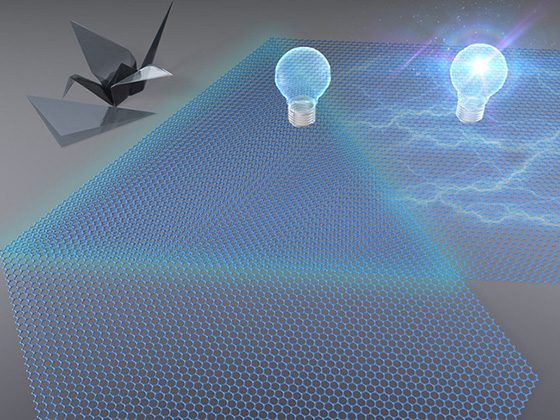- Home
- > Research
- > Research Highlights
- > Vol. 61 First Fabrication of fBBLG/hBN・・・
 Research Highlights
Research Highlights
[Vol. 61]
First Fabrication of fBBLG/hBN Superlattices
A team at MANA has demonstrated for the first time the fabrication of folded bilayer-bilayer graphene (fBBLG)/hexagonal boron nitride (hBN) superlattices. This achievement could pave the way for expanded applications of superlattices, such as in a variety of quantum devices.

Graphene superlattices represent a novel class of quantum metamaterials that have promising prospects. They have been generating a lot of attention recently, ever since the discovery of superconductivity in twisted bilayer graphene (BLG). This was followed by studies related to twisted bilayer-bilayer graphene. Bernal-stacked BLG has a parabolic energy dispersion with a four-fold spin and valley degeneracy.
A superlattice is a periodic structure of layers of two or more materials. Typically, the width of layers is orders of magnitude larger than the lattice constant, and is limited by the growth of the structure. The MANA team’s superlattices are made up of vertically stacked ultrathin/atomic-layer quasi 2D materials.
The MANA team’s results point to the emergence of a unique electronic band structure in the fBBLG, which could provide a way for investigating correlated electron phenomena by performing energy-band engineering with superlattice structures.
The results of this study indicate the emergence of a unique electronic band structure in fBBLG, which could be modified by the moiré superlattice potential. Although a systematic way to fold graphene is still lacking, it should be a fruitful topic of future research, leading to 2D paper-folding engineering like “origami.” The team’s results suggest a possible way to engineer 2D electronic systems by mechanical folding, similar to "tear and stack" for twisted heterostructures.
This work could lead the way to expanded applications of superlattices, including quantum devices such as Bloch oscillators, quantum cascade lasers and terahertz source generators.
This research was carried out by Takuya Iwasaki (ICYS-WPI-MANA Research Fellow) and his collaborators.
Reference
"Fabrication of folded bilayer-bilayer graphene/hexagonal boron nitride superlattices"
Takuya Iwasaki, Yoshifumi Morita, Shu Nakaharai, Yutaka Wakayama, Eiichiro Watanabe, Daiju Tsuya, Kenji Watanabe, Takashi Taniguchi and Satoshi Moriyama
Journal : Applied Physics Express [ March 5, 2020 ]
DOI : 10.35848/1882-0786/ab790d
(Hot topics on this research)
Novel electronic characteristics in “folded bilayer-bilayer graphene/hexagonal boron nitride superlattices” (13 March 2020)
https://www.nims.go.jp/mana/news_room/hottopics/2020031301.html
(MANA E-BULLETIN)
https://www.nims.go.jp/mana/ebulletin/
Takuya Iwasaki, Yoshifumi Morita, Shu Nakaharai, Yutaka Wakayama, Eiichiro Watanabe, Daiju Tsuya, Kenji Watanabe, Takashi Taniguchi and Satoshi Moriyama
Journal : Applied Physics Express [ March 5, 2020 ]
DOI : 10.35848/1882-0786/ab790d
(Hot topics on this research)
Novel electronic characteristics in “folded bilayer-bilayer graphene/hexagonal boron nitride superlattices” (13 March 2020)
https://www.nims.go.jp/mana/news_room/hottopics/2020031301.html
(MANA E-BULLETIN)
https://www.nims.go.jp/mana/ebulletin/
Affiliations
International Center for Materials Nanoarchitectonics (WPI-MANA), National Institute for Materials Science (NIMS), Namiki 1-1, Tsukuba, Ibaraki 305-0044, Japan
Contact information
Research Center for Materials Nanoarchitectonics (MANA)
National Institute for Materials Science
1-1 Namiki, Tsukuba, Ibaraki 305-0044 Japan
Phone: +81-29-860-4710
E-mail: mana-pr[AT]nims.go.jp
1-1 Namiki, Tsukuba, Ibaraki 305-0044 Japan
Phone: +81-29-860-4710
E-mail: mana-pr[AT]nims.go.jp

